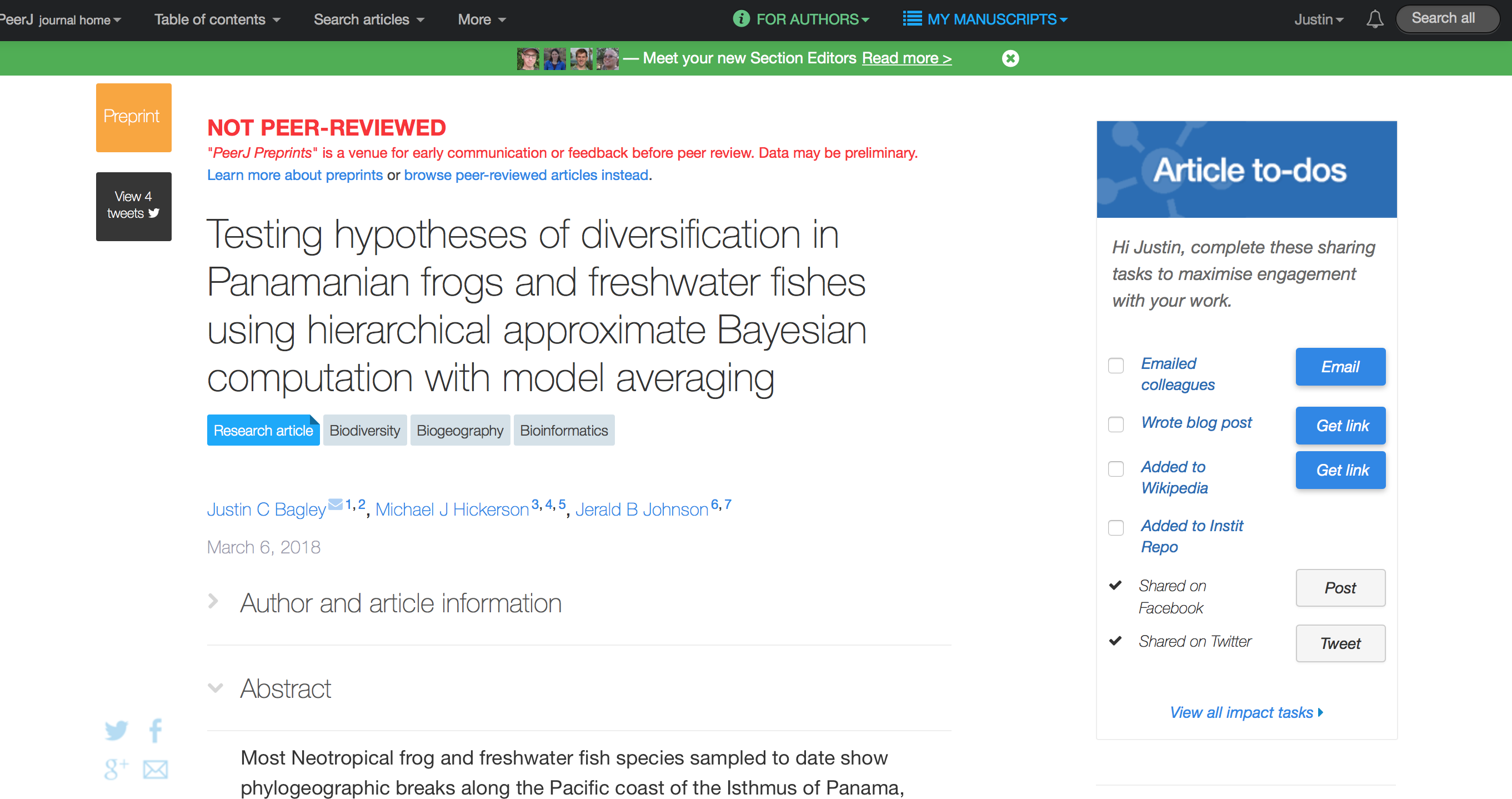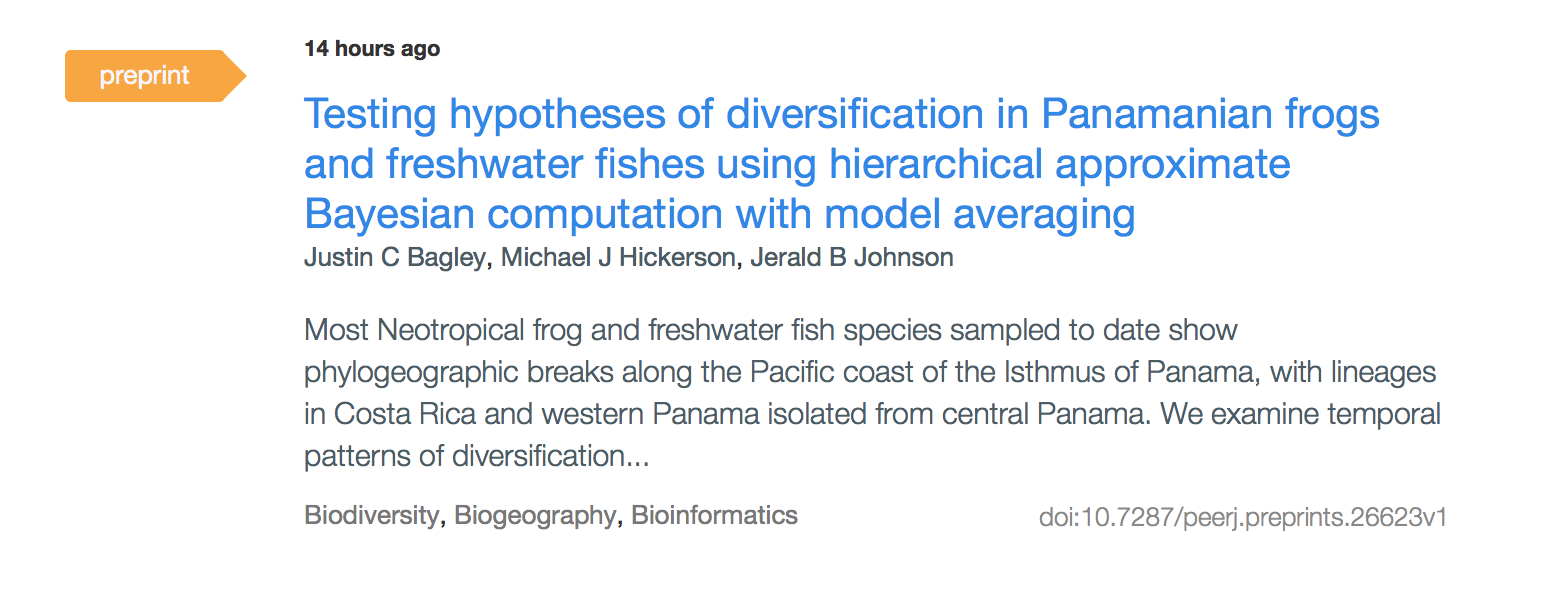Thanks to PeerJ Preprints I am very pleased to be able to report two pieces of positive news for today:
- **Our new preprint, which presents the results of a comparative phylogeography study, is now published online at PeerJ Preprints (as of yesterday) and **
- I had a very positive experience submitting my preprint to this service.
The Paper
One reason I’m excited about this new paper is that it addresses a highly relevant issue in evolutionary biology: inferring mechanisms underpinning biotic assembly and diversification in Neotropical species assemblages.
Inferring the histories of regional species assemblages helps us understand why there are so many species in the Neotropics, e.g. in biodiversity ‘hotspots’ in Central and South America (Myers et al. 2000). Unfortunately, understanding many aspects of the evolution of Neotropical biotas (e.g. dispersal, speciation) has remained elusive because past attempts were limited to distributional data alone, and many groups have not been assessed using statistical methods permitting inference from molecular data. Insights from comparative phylogeography—the field that infers the histories of assemblages by testing for spatial and temporal phylogeographic congruence across codistributed taxa (e.g. Bermingham and Martin 1998; Arbogast & Kenagy 2001)—remain particularly underdeveloped. One reason for this is that it is difficult to generate or organize comparative DNA datasets for multiple codistributed taxa. It is also difficult to distinguish between models of diversification, and directly interpreting the number of divergence events within a group of species from gene divergences alone can lead to erroneous conclusions.
In our study, which is currently under review, we focused on testing models of temporal diversification of frogs and freshwater fishes that share a common genetic divergence along the western Panama isthmus (WPI; the ‘WPI break’), which we identified in a recent review of lower Central American phylogeography studies (Bagley & Johnson 2014). A growing number of taxa share the WPI break, and biogeographical hypotheses have been advanced to explain regional species distributions and genetic breaks. However, temporal diversification of frogs and fishes in this region has been little explored.
I’m happy to be able to say that we conducted the first tests for synchronous diversification of frogs and fishes at the WPI break by analyzing mitochondrial DNA sequences using recently developed hierarchical ABC (hABC) methods accounting for uncertainty in model selection using modeling averaging, as well as Bayesian divergence dating methods. Our results supported synchronous divergences in the frog and fish assemblages in several cases (e.g. hyperparameters); however, Bayes factors provided equivocal support for models with single versus multiple divergences. We thus conducted hypotheses tests based on improved, assemblage-level divergence time estimates, which showed that frogs diversified in the Plio–Pleistocene more recently than predicted by previous hypotheses, and that fishes diversified across the WPI break in the Pleistocene.
Overall, by comparing our results to external data from geological studies/GIS data and regional phylogeographic syntheses, we show the first evidence that the WPI break could have been generated in frogs, and maintained in both assemblages, in response to sea-level fluctuations. Our study demonstrates how hABC analyses using a synthesis of existing genetic data from multiple studies, integrated with external geospatial data, can yield novel biogeographical insights despite challenges and limitations associated with using a single locus (mtDNA) in comparative phylogeography studies (which we discuss repeatedly in the paper), and associated with computational demands of analyzing multiple species/lineages at once.
The PeerJ Preprints Experience
I’ll keep my comments on PeerJ Preprints brief, except to say that the only other approach that I could think of that could possibly improve on the website and user experience of submitting a preprint through their system would be an automated system that somehow extracted all manuscript files and author information from a single compressed zip archive of files and metadata. I mean, regarding manuscript submission and managing revisions as an author, as well as submitting reviews as a reviewer, my sense is that PeerJ has one of the best websites and submission systems that I’ve ever interacted with. The design is beautiful and intuitive. The website gives excellent directions. And, when you’re done and your preprint is checked, they will immediately post the preprint online! It could be up within 1 business day.
As an extra bonus, you’ll find that when you then attempt to go view the preprint, while logged in, that PeerJ’s website gives you a nice little checklist of things to do to promote and disseminate your article. This checklist is given in a box with the heading “Article to-dos” (see blue box, right side of screenshot below):
[ ]
]
I thought that was pretty smart. It also provides a useful reminder, for scientists of all skill or training levels and all backgrounds, of ways in which you can promote your article, especially using social media.
Cheers, ~J
